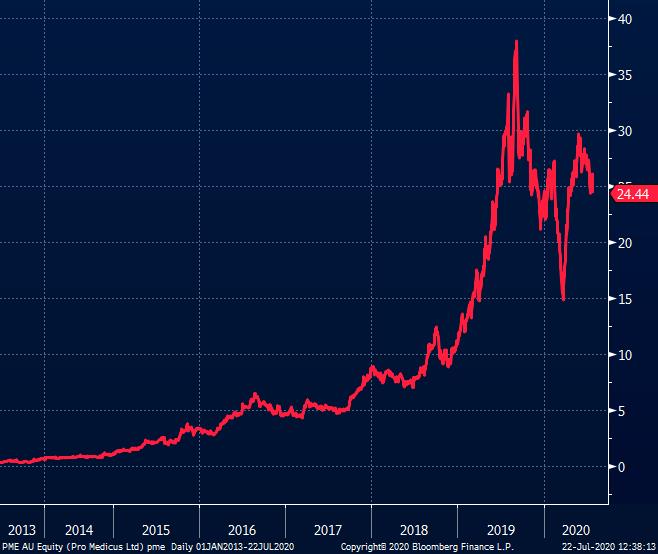Zero to Hero: How Pro Medicus became a $2.7bn ASX200 stock without raising a cent

Pick the right ASX stock and the gains can be enormous
Radiology software stock Pro Medicus (ASX:PME) was once a small cap trading for only around 50c a share. Fast forward to today and it is now worth almost $25 a share — a gain of over 5,000 per cent.
How did this company succeed in a sector where others have failed or are acquired before they can realise their full potential?
The catalyst has been the success of its radiology platform, Visage 7, that allows medical images to be accessed anywhere and with lower data requirements.
What makes the company’s success unique is that it’s been done without any capital raisings. Co-founder Dr Sam Hupert admits his company is no ordinary stock.
“We’re a little unusual because we see ourselves as a growth company but we make profits, we accrue cash, we pay dividends but we still continue to grow,” he told Stockhead.
“So it’s a bit of a hybrid compared to some of the other models out there today.”
Computers would be the new form of literacy
Pro Medicus’ was founded back in 1983 by Dr Hupert and Anthony Hall.
Dr Hupert was then a recent medical school graduate who saw potential for the use of computers in medicine, even in those days when computers were much more complicated.
“Most of the computing that was available was like kits and boards you’d put together. I’m not a tech head, I just thought computers would be the new form of literacy,” he told Stockhead.
“In my medical school training the word computer was never used, so I thought I’d buy one to see what it’s all about and that started the process.”
Dr Hupert and Hall provided all the finance and equity in the early years.
In the early years, Pro Medicus focused on helping medical practices do business more easily, helping them keep clinical records as well as manage building and scheduling.
Over time, it expanded into helping patients receive their radiology diagnostic results faster.
Surviving the ‘tech wreck’
In 2000, Dr Hupert and Hall decided to list Pro Medicus and it made its debut on October 10 of that year.
But the listing was initially delayed by the dotcom bubble burst, which happened the weekend before the company was originally due to announce its listing.
“So when we met with our brokers and advisors that following Monday we realised we had to park the float,” Dr Hupert explained.
“But then fortunately later that year in August, September markets opened back up, particularly for companies that were profitable and had a revenue stream and a business model.”
Initially, listed life for Pro Medicus was a slow and steady journey both with its e-health offerings and digital radiology products.
Early wins were notched in Australia, but its first overseas contract wasn’t secured until late 2002 when it signed on MIA Group’s UK subsidiary following its Australian counterpart.
Entering North America
Entry into North America came in 2004 through a licensing deal with digital imaging conglomerate Agfa.
Dr Hupert says the Agfa deal was the result of Agfa’s dominance in the US and Australia as well as a major epiphany.
“We realised that the clinicians and radiologists were transforming from film to computer-based reporting – looking at images on screen,” he told Stockhead.
“Which made a huge heap of sense because a lot of the cameras or modalities that you take for granted today, CT and MRI, were digital anyway. So you were just converting them to analogue and printing them when you used film.
“And the other thing that happened is the price of silver went through the roof and x-ray film is one big dump of silver so it became prohibitively expensive.
“So we saw that writing on the wall and we wrote some middleware that linked our business-oriented software with the clinical software that was then done by larger companies.”
Breaking up with Afga & finding Visage
But by 2007 Dr Hupert realised Pro Medicus had to go in another direction.
“In 2007, we realised the wheels were falling off Agfa’s cart and we just thought they are a bigger company than us, they’re going in a different direction,” he explained.
“We need to secure or acquire our own clinical piece.”
Pro Medicus eventually bought a company called Visage Imaging from Mercury Systems (NDQ:MRCY). The transaction occurred right in the depths of the GFC.
A smart move
Dr Hupert says it was the best business decision he ever made, notwithstanding some renovations were required.
“We acquired two major components when we had acquired Visage, one was sensational, and one was awful,” he explained.
“The sensational bit was the original team that developed the whole underlying technology, they had sold it into Mercury.
“The two co-inventors of the whole platform are still with us, as are over 90 per cent of research and development staff from original acquisition – one’s our CTO and one’s our head of development.
“The bad part was we acquired a US organisation [with] sales and marketing that was far less than optimal. For the first few years we were going backwards and losing money in the US.
“But when I came back as CEO in 2010 — I had stepped back in 2007 — we pretty much blew up the US operations and started again.”
The catalyst for takeoff
2013 was the year Pro Medicus really began taking off as it won several high-profile clients in the US. Among the more critical were major radiology group vRad and veterans affairs network (VISN23).
In 2014, it announced a six-year deal worth $20m with a large US health network.
“That was a pivotal point for us because it was one of the biggest deals with the market at the time and there were 29 other starters that got the request for proposal including all the majors like GE, Phillips and Siemens,” Dr Hupert said.
“Lo and behold a company no one ever heard about from Australia had won — that was us — and it really set us in the market. From then on the US has been a profitable, positive experience for us.”
The company’s share price hasn’t looked back since mid-2013, surging over 5,000 per cent.
Pro Medicus (ASX:PME) share price since 2013

Dr Hupert says he’s heard from a number of shareholders thankful for the gains notched up in recent years and it is rewarding for him.
“We often get letters or people saying things such as I’ve been able to buy a house for my son or I sold a portion of my shares and I did this and I think that’s fantastic,” he said.
“That’s rewarding for us because we know these people, we met with these people. They had faith in us and they’ve been able transfer it into something meaningful for themselves.”
What next for Pro Medicus?
Dr Hupert acknowledges his company is in a good place right now.
While the company does have business in Australia, the US is the world’s largest market and accounts for most of the company’s revenues.
“The US is a very big and competitive market and I tell my staff I liken it to being centre court at Wimbledon, we’re on centre court and we seem to be wining so why get off?” he said.
But Dr Hupert believes the market and his company have more room to grow with more deals in the US and the goal of breaking into Europe.
“The important thing is we believe we can maintain our status and our aim as a growth company organically,” he told Stockhead.
“And there are a few irons in our fire including a bigger footprint in the US – that’s a given.”
Artificial intelligence
But there’s a bigger elephant in the room that’s on the cusp of disrupting the market: artificial intelligence (AI). And Pro Medicus hopes to be at the forefront of it.
“There’s no question [AI] will become mainstream particularly in radiology,” Dr Hupert said.
“There won’t be one winner and a whole lot of losers. There are thousands of people writing algorithms, every VC funded group from Tel Aviv to Sydney literally.
“And people forget the academics we deal with have massive data science labs – Mayo [Clinic] has 450 PhDs just working on AI in radiology alone.”
However, Dr Hupert pointed out there was still some way to go.
“It’s an exciting future but few companies if any can commercialise AI quite yet, it’s a little early. There’s a lot of promise but no one has been able to do it in a mainstream way,” he said.
“But I think it will change in mid-term future, will it be 18, 24 months? I don’t think anyone knows. So we set ourselves up to be there so when it does occur we hope we are in midst of things.”
Related Topics

UNLOCK INSIGHTS
Discover the untold stories of emerging ASX stocks.
Daily news and expert analysis, it's free to subscribe.
By proceeding, you confirm you understand that we handle personal information in accordance with our Privacy Policy.








